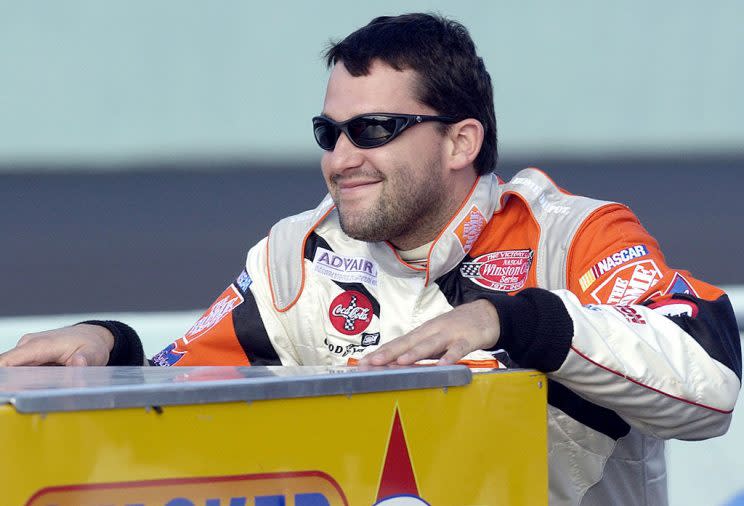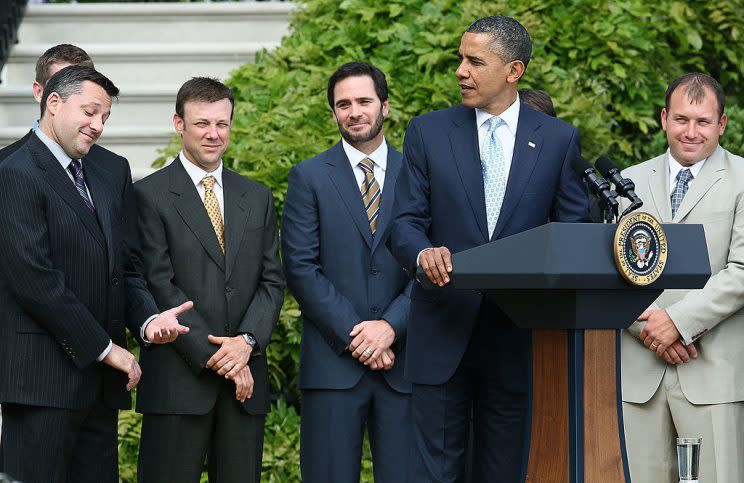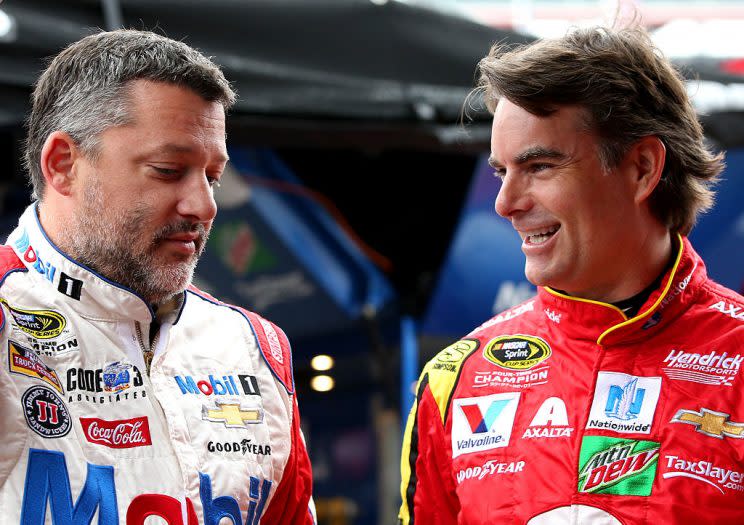Tony Stewart's career began with a bang, ends with a whisper
Tony Stewart will turn his last laps as a NASCAR driver at Homestead this weekend, and when he rolls off into the Florida sunset, so too will NASCAR’s last link to its fiery, brawling, race-anything-that-moves past. The world has moved on since the hell-bent days of Earnhardt and Wallace and Waltrip and Yarborough, and while Stewart carried their flag as deep into the 21st century as he could, time has finally come for him, too.
On one hand, Stewart posted one of the great NASCAR careers in history: three championships, 49 Cup races won, victories at virtually every track on the circuit, and a connection with a fan base rarely managed before and maybe never again.
But the first page of any career retrospective of the man nicknamed “Smoke” must also include the fatal accident at a small track in upstate New York, and stories of a mercurial, run-wide-open temper that made enemies up and down pit road.
Truth is, when it came to racing cars, no one outdueled Tony Stewart. But his demons sure put up a hell of a fight.

Tony Stewart was born in Indiana an hour south of Indianapolis Motor Speedway, and when he was eight, he began hacking a path from his hometown to the track, one trophy at a time. He drove anything with wheels – go-karts, modifieds, midgets, sprint cars and he almost always drove whatever he was in faster than anyone around him. But he learned the lesson so many did before him: the money drains faster than the car runs.
Rushville, Indiana, 1993. Stewart has spent the last few months crashing at a friend’s house, working a drill press 40 hours a week for $5 an hour. His racing dreams are receding in the rearview mirror. Stewart decides to take one last gamble, borrowing a couple hundred bucks from his boss to run the Copper Classic, an open-wheel USAC race in Phoenix. He places second, winning $3,500. Running numbers in his head to figure just how long it would take to make that money in the machine shop, Stewart decides to throw himself into racing, deciding, “It’s now or never.”
Stewart stormed upward through the USAC (United States Auto Club) ranks, winning every major trophy he could. He moved onward to the Indy Racing League, claiming the series’ 1997 title. At roughly the same time, he began driving for Joe Gibbs Racing in NASCAR’s triple-A series. He showed enough promise that Gibbs decided Stewart was ready for the big time, moving him to the Cup level in 1999 and effectively ending his open-wheel career.
NASCAR had no idea what was coming.
Daytona, 1999. Stewart, a heralded rookie making a jump from Indy Racing to the thick-muscled stock cars of NASCAR, is leading one of the 125-mile Duel races to qualify for the Daytona 500. He’s thinking this NASCAR gig isn’t all that tough, and then he sees Dale Earnhardt in the rearview mirror. A couple flicks of the wrist, and Earnhardt blows right past Stewart, taking most of the field with him. “OK, here we go,” Stewart thinks. “I guess I’m in NASCAR.”
Stewart arrived in NASCAR so perfectly formed for the sport that it’s tough to even remember a time when he wasn’t there. Just a handful of months into his debut season, he proclaimed, “This is where I want to be for 20 or 30 years. This is where I want to retire.”
Stewart won three races his first year, six his second, and immediately established himself as one of the sport’s fixtures. He finished second in the standings to Jeff Gordon in 2001, and then won the then-Winston Cup championship in 2002.
From there, he rode the rebellious, in-your-face wave of a sport on the rise yet still reeling from Earnhardt’s death in 2001. He piled up fans by the thousands, in spite of – or maybe because of – his volcanic temper. He slapped a tape recorder out of a reporter’s hand in 2001, shoved a photographer in 2002. He also veered hard into the peculiar, as when he brought his pet monkey Mojo to the track. The 20-pound monkey was, as Stewart put it, “like having a child on crack.”
But he also kept winning, notching his second championship in 2005 and establishing himself as one of the finest drivers of his generation.
Columbus, Indiana, December 2005. Winter has rolled in, bringing with it a 28-inch dumping of snowfall. Stewart spends hours in his Humvee, freeing more than 20 stuck motorists. At 3 in the morning, he leaps into a city snowplow and spends the next four hours clearing the streets.
Talk of “two Tonys” started almost as soon as Stewart began his Cup career. There was the iron-headed sonofabitch and the warm-hearted teddy bear, the bastard who fought with anyone and everyone and the buddy who always had time for the young and the sick.
How do you even resolve those two? How could you get behind a guy who’d get angry enough to throw his helmet at Matt Kenseth while a race was in progress, and how could you do anything but support a guy who regularly loans his private plane to help friends in the racing community in crisis?

April 2007. Stewart opens a microphone on his weekly Sirius radio show and sends shock waves throughout the sport by going in hard on the way late-race caution flags bunch up the field, making for “better” finishes. “I guess NASCAR thinks, ‘Hey, wrestling worked, and it was for the most part staged, so I guess it’s going to work in racing, too,’ ” Stewart tells his audience. “I can’t understand how long the fans are going to let NASCAR treat them like they’re stupid before the fans finally turn on NASCAR. I don’t know that they’ve run a fair race all year.” The ripples from these lines will resonate through NASCAR for the rest of Stewart’s career.
After Earnhardt’s death, many looked to Stewart as the pulse of the garage, the connection between working-class fans and the folks with money up in the skyboxes. Stewart moved in the sport’s elite circles, but he was never more comfortable than when he was down among the grease and parts.
Stewart loves racing at every level, and he spent much of his Cup career racing on off weekends, weeknights, anywhere he could find an engine and an oval. He used to race under a variety of aliases, including “Luke Warmwater.” Whether that was to throw off fans or his superiors at Joe Gibbs Racing is debatable.
Anonymity worked fine earlier in Stewart’s career, but the advent of social media annihilated his secrecy. Now you only needed to look to Twitter to see Stewart driving a tractor at a dirt track or getting in a shouting match with a fan in the bleachers.
There are reasons why owners cringe when their drivers participate in non-NASCAR events, and Stewart brought that all home in 2013 when he suffered a broken leg at a midweek sprint car race in southern Iowa. He was out for the season, he said, though he never even hinted that he’d stop short-track racing.
And then came New York.
Canandaigua, New York, August 2014. It’s just another race at just another track, just another in the endless line of showdowns where the local guys think they’ll have a go at the god of racing in America. Except this time, a 20-year-old racer by the name of Kevin Ward Jr. gets knocked into the wall, and he gets out of his car. Not unlike Stewart in these situations, he’s consumed with rage. And from the wreckage of his car in a dark corner of the track, he spots Stewart and begins pointing and walking straight toward Stewart’s car as it approaches.
Within hours, the Ontario County sheriff’s department indicated that its initial evidence showed that Ward’s death from blunt force trauma was a tragic accident, unavoidable given the circumstances. Five weeks later, a grand jury declined to indict Stewart on charges of manslaughter or criminally negligent homicide.
Stewart, in seclusion, sat out several races. When he returned to the public eye nearly a month later, at a media conference in Atlanta, he looked 10 years older, his hair grayer and his eyes sunken. Even as he tried to put his pain into words and express sympathy for Ward’s family, critics pointed to his history, as if one could draw a direct line from slapping tape recorders and slinging helmets to running over a human being.
The Kevin Ward Jr. story will follow him for the rest of his life, an army of critics ranging from anonymous Twitter trolls to at least one fellow driver – Ryan Newman, just this past September – ready to remind him of how another driver died beneath his wheels.

Sonoma, California, June 2016. Stewart has already announced he’ll retire from NASCAR at the end of the season, and he’s missed the final Daytona 500 of his career no thanks to an injury suffered while (of course) off-road riding. He’s now in the midst of an 84-race winless streak, and his career is sputtering on fumes to the finish line. But on this weekend, one last bit of magic: Stewart, hyperaggressive one last time, outduels Denny Hamlin to get one final win.
The win put Stewart in the Chase, NASCAR’s postseason, but his run ended quickly and mercifully, as he expected it would. This wouldn’t be a repeat of 2011, when he limped into the Chase only to win five of the 10 races and snatch a third championship. No, there would be no miracle ending for Stewart.
He’s not done racing cars by any stretch. He’s already made plans to race elsewhere, he says, though he won’t give details. And he will maintain a visible presence in NASCAR. His team, Stewart-Haas Racing, is one of the sport’s powerhouses. The eight-year-old team has won two championships in the last six seasons.
After 18 years of making noise, Stewart leaves NASCAR with none of the fanfare Jeff Gordon received last year, and that’s a shame. Perhaps because Stewart requested a calmer departure – no miniature ponies or go-karts, please – and perhaps because Stewart’s legacy is a far more complicated one than Gordon’s. Still, it means Tony Stewart is rolling on to the next phase of his life in an unfamiliar way.
Quietly.
____
Jay Busbee is a writer for Yahoo Sports and the author of EARNHARDT NATION, on sale now at Amazon or wherever books are sold. Contact him at jay.busbee@yahoo.com or find him on Twitter or on Facebook.

 Yahoo Sports
Yahoo Sports 
